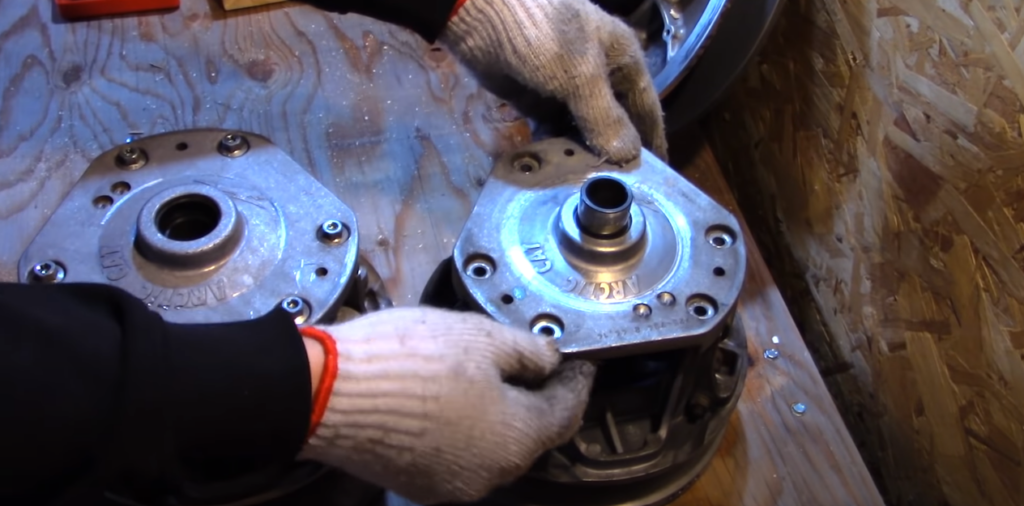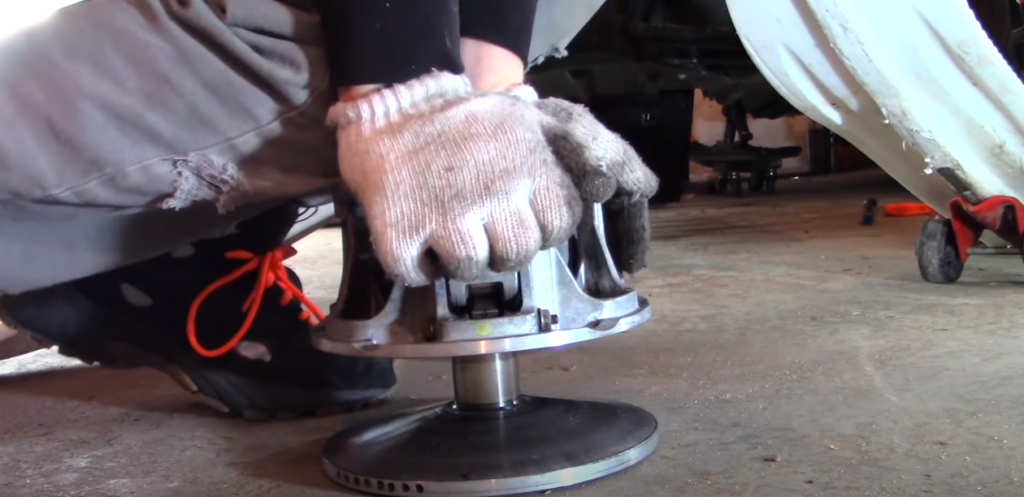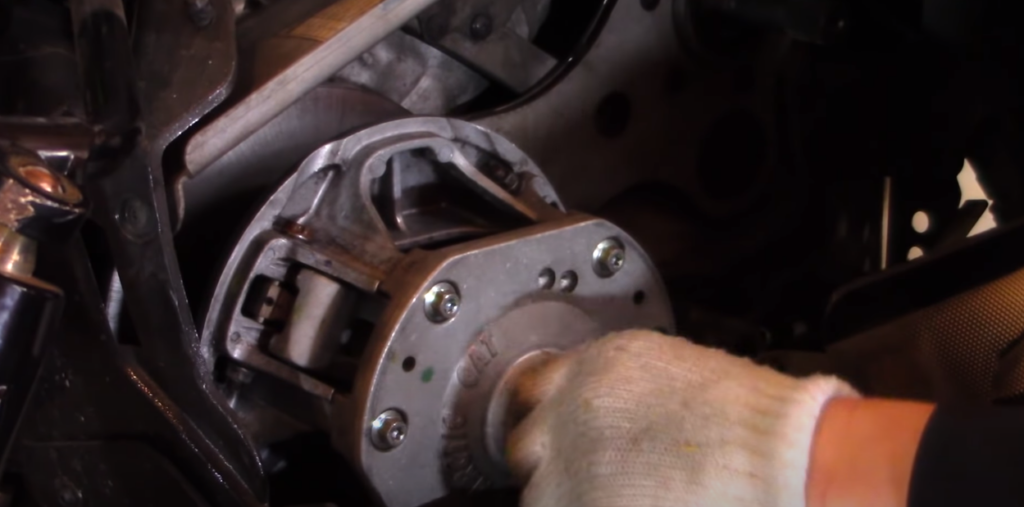The snowmobile’s clutch system plays a pivotal role in its performance and overall functionality. As snowmobilers can attest, a minor malfunction within this component can quickly escalate, leading to a compromised ride, decreased safety, and potential further damage. As such, it’s crucial to recognize the early signs of clutching problems, understand the root causes, and apply effective solutions.
Key Components of the Snowmobile Clutch System
Before delving into the problems, it’s vital to comprehend the snowmobile’s clutch system intricacies. The primary clutch (also known as the drive clutch) connects to the engine, while the secondary clutch (or driven clutch) connects to the track’s drive system.
Primary Clutch
- Sheaves: These are the two halves of the clutch. They move together and apart, depending on engine RPM, to squeeze the belt and transfer power;
- Weights: As RPMs increase, these swing out due to centrifugal force, pushing the sheaves together;
- Spring: This component resists the weights, ensuring that the clutch doesn’t engage immediately upon starting the engine.
Secondary Clutch
- Sheaves: Like the primary clutch, these squeeze and release the belt. They adjust based on the torque requirements from the track;
- Helix: This component controls the rate at which the sheaves move;
- Spring: Dictates the tension on the belt and helps the sheaves return to their start position.
Common Snowmobile Clutching Problems and Their Causes

Snowmobiling is an exhilarating winter activity, but like any machinery, snowmobiles can experience clutching problems that affect their performance and reliability. Understanding these issues and their underlying causes is essential for maintaining a smooth and enjoyable riding experience.
1. Slipping Clutch
The engine’s RPM increases, but acceleration is sluggish.
| Cause | Description |
|---|---|
| Worn-out clutch springs | Over time, the tension in clutch springs may weaken, leading to insufficient pressure on the clutch plates. This results in reduced power transmission and sluggish acceleration. |
| Damaged or contaminated clutch sheaves | Clutch sheaves, responsible for engaging and disengaging the clutch, can become damaged or contaminated with debris, oil, or dirt. This compromises the friction needed for smooth engagement, causing slipping. |
| Oily or dirty residues | Residues from oil or dirt can accumulate on the clutch components, reducing the friction necessary for proper clutch engagement. This results in the engine revving without a corresponding increase in speed. |
2. Hard Shifting
Challenges when attempting to shift gears, leading to jerks or sudden thrusts.
| Cause | Description |
|---|---|
| Damaged or misaligned components | Misalignment or damage to clutch components, such as the primary and secondary clutches, can hinder the smooth transition between gears. This leads to jerky shifts and even sudden thrusts, impacting the overall riding experience. |
| Insufficient lubrication | Proper lubrication is crucial for smooth clutch operation. Inadequate lubrication causes friction between components, making gear shifting difficult and uncomfortable. |
| Deteriorated belt | The snowmobile’s belt plays a pivotal role in synchronous movement between gears. A deteriorated or worn-out belt can disrupt this movement, making shifting harder and less predictable. |
3. Excessive Heat
Overheated clutch components after regular rides.
| Cause | Description |
|---|---|
| Misalignment and incorrect belt deflection | If the primary and secondary clutches are misaligned or the belt deflection is not within the recommended range, excessive friction and heat can build up. This can lead to overheating of the clutch components and reduced performance. |
| Overburdening the snowmobile | Pushing the snowmobile beyond its designated carrying capacity can strain the clutch system, causing it to generate more heat than it can dissipate. This compromises the clutch’s efficiency and can lead to overheating. |
| High-speed rides without breaks | Continuous high-speed riding without giving the clutch a chance to cool down can lead to excessive heat buildup. This prolonged stress can eventually cause damage to the clutch components and decrease their lifespan. |
4. Clutch Squeal or Noise
Unusual noises or high-pitched squeals during clutch engagement.
| Cause | Description |
|---|---|
| Components becoming loose | Over time, the repeated engagement and disengagement of the clutch can lead to loosening of various components. This results in vibrations and noises during clutch operation. |
| Lack of lubrication | Bushings and other moving parts within the clutch assembly require proper lubrication to prevent friction-induced noises. Insufficient lubrication can lead to squealing or other unusual sounds. |
| Glazing or micro-damages | Clutch sheaves subjected to wear and tear or contaminants can develop glazing or micro-damages. These imperfections can cause vibrations and noises during clutch engagement. |
5. Inconsistent Engagement
Variable clutch engagement RPMs during different startups.
| Cause | Description |
|---|---|
| Deteriorated or broken clutch spring | A worn-out or broken clutch spring cannot maintain the necessary pressure for consistent engagement. This leads to varying RPMs during different starts and compromises performance. |
| Debris within the clutch mechanism | Intruding debris, such as dirt, dust, or particles, can hinder the smooth operation of the clutch. This disruption affects engagement consistency and overall riding experience. |
| Wear and tear on clutch weights | Clutch weights play a role in determining engagement RPMs. Wear and tear on these weights can lead to imbalanced engagement and varying performance levels. |
Diagnosing Snowmobile Clutching Problems

Mastering the art of diagnosing these issues is like having a secret toolkit to keep your snowmobile’s performance at its peak. We’ll unravel a step-by-step process with engaging techniques to diagnose common clutching problems and ensure you’re back to carving through the snow with ease.
1. Visual Inspection
The journey to pinpointing clutch problems begins with your eyes. Conduct a meticulous visual inspection to unveil immediate hints about the health of your clutch system:
- Start by giving your snowmobile’s clutch a comprehensive look-over. Examine for visible damages, cracks, or any missing parts. These obvious signs can provide valuable initial clues about what might be amiss;
- Turn your attention to the clutch sheaves – the discs responsible for clutch engagement. Look out for uneven or glazed surfaces. Such imperfections can be contributing factors to slippage and unwelcome noises.
2. Spin Test
Safety is paramount. Before you embark on the spin test, ensure your snowmobile is securely turned off and on level ground. Now, let’s get tactile:
- With a gentle touch, manually spin the secondary clutch. Here, the essence is smoothness – a well-maintained clutch should rotate effortlessly, devoid of any unexpected hitches or resistance.
3. Alignment Examination
The dance of the clutches relies heavily on alignment. Like a conductor with a baton, you’ll use a straight edge or a specialized alignment tool to orchestrate this performance:
- Both the primary and secondary clutches must align perfectly for optimal performance. Observe closely for any deviations – misalignment can be a breeding ground for issues;
- While you’re at it, don’t forget to check the shaft and bushings for signs of wear. These telltale signs can guide you towards potential issues affecting alignment.
4. Belt Analysis
The belt is the unsung hero of clutching. It’s time to read between the lines:
- Examine the belt for any noticeable wear, thinning, fraying, or glazing. A compromised belt isn’t just a mere inconvenience – it can dramatically impact clutch performance and even escalate into more extensive damages.
5. Temperature Check
After a spirited ride, temperature can provide valuable insights into your clutch’s well-being:
- Carefully gauge the temperature of the clutch components. Consistently excessive heat isn’t just a matter of discomfort; it can signal internal problems or misalignment that demand attention.
Solutions to Clutching Problems

1. Slipping Clutch
A slipping clutch can dampen your snowmobiling spirit, but fear not – we have the sheet music for a harmonious fix:
- If you spot clutch springs that have weathered their fair share, it’s time for a change. Replacing worn-out springs restores the tension needed for robust engagement;
- Give your clutch sheaves a refreshing makeover. Employ a non-residue cleaner to scrub away dirt and grime, or if damage is apparent, opt for a replacement;
- The culprit might be oily residues sabotaging friction. Ensure your clutch is pristine and free of contaminants to regain optimal performance.
2. Hard Shifting
Resolving hard shifting issues requires the finesse of a skilled conductor – follow these notes:
- Realignment of clutch components is the key to synchronized movement. Like tuning an orchestra, ensure all parts are in perfect harmony;
- Lubrication is the maestro’s touch. Apply the recommended lubricant to minimize friction and guarantee silky-smooth gear transitions;
- If your snowmobile’s belt tells a tale of deterioration, consider it time for an encore. A fresh belt can transform shifting into a seamless composition.
3. Excessive Heat
An overheated clutch can disrupt your snowmobile’s rhythm, but we have the perfect crescendo of solutions:
- Align those clutches! If the primary and secondary clutches are out of tune, realignment is your symphony’s conductor waving the baton;
- Ease the burden if you’re frequently hauling hefty loads. Your snowmobile has its limits – respecting them can prevent overheating and ensure a harmonious ride;
- Prolonged high-speed escapades need interludes. Implement regular breaks during these journeys to let the clutch cool down and prevent excessive heat buildup.
4. Clutch Squeal
Unwanted squeals can disrupt the serene snowmobile sonata. Fear not, we’ve curated the remedies:
- A tightening movement akin to tuning strings can silence loose components. If you spot any, give them a snug twist;
- Dry bushings are notorious for unwanted noise. Apply the magic of lubrication to these areas and let the silent serenade continue;
- Glazed sheaves or micro-damages are like a discordant note. Replace these compromised components to restore the harmonious engagement of your clutch.
5. Inconsistent Engagement
Inconsistency has no place in a melodious snowmobile ride. Here’s how to maintain equilibrium:
- Clutch springs are the heartbeat of consistent engagement. If they’re compromised, replace them to keep the rhythm intact;
- Regular cleaning sweeps away debris that can tarnish the harmony. A clean clutch ensures a smooth symphony throughout your journey;
- Weights out of balance can throw off your snowmobile’s rhythm. Consider replacing them to restore the equilibrium of engagement.
Conclusion
Understanding the intricacies of the snowmobile clutch system is paramount. Timely detection, thorough diagnosis, and effective solutions can ensure both the rider’s safety and the snowmobile’s longevity. Regular maintenance checks, proper alignment, and awareness of common problems can make all the difference.
FAQ
Individual components can be replaced as needed. However, if multiple parts are worn or damaged, a comprehensive repair or replacement might be more economical.
Regular inspections, timely maintenance, and adhering to the snowmobile’s weight capacity can significantly prolong the clutch’s lifespan.
While aftermarket clutching can enhance performance, it’s essential to ensure compatibility and quality. Always consult with a specialist before making modifications.
Yes, prolonged clutch issues can strain the engine, affect the drivetrain, and compromise overall safety.
While there’s no strict timeline, a visual inspection for wear and tear can guide decisions. Typically, replacing every 1,000-1,500 miles is recommended, but always refer to the manufacturer’s guidelines.
